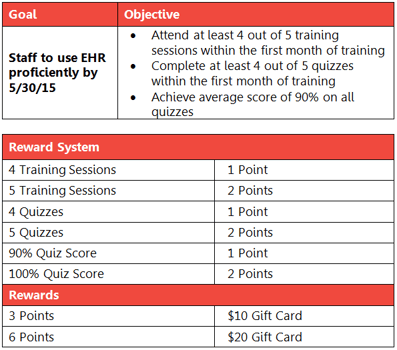Rewarding Staff Who Embrace EHR Software Change
For any practice planning to implement a new practice management and EHR software, expect the journey to be an adventure for your whole practice. Change management is going to be very important in making sure that the transition to the new system goes smoothly.
It’s important to keep everybody motivated, especially staff who are usually resistant to change. An effective way to keep your staff motivated is the use of positive reinforcement, like a reward system.
Today, we show you how you can easily build an incentive system for your staff throughout the implementation process.
How to Incentivize Staff When Switching EHR Software
 1. Select goals
1. Select goals
Goals can be broad statements that don’t necessarily contain specific objectives. To set a goal, you’ll need to ask you and your staff what you would want to achieve at the end of the implementation. Most practices would want their staff to use the new system proficiently, with a long term goal or increasing practice efficiency and revenue. But let’s stick to short term goals for this incentive program. Examples of those goals include:
- All staff to use new EHR software proficiently by [insert date or month].
- Go live with all live patient data by [insert date or month].
2. Set objectives
Now, let’s talk about how to achieve those goals. You’ll need to set some quantifiable objectives and actionable items for your staff. Include a time frame on when they should achieve these objectives. There could be multiple objectives to achieve your goal. For example, if your goal is for all your staff to proficiently use the EHR software in 3 months, some objectives can include:
- Attended at least 8 out of 10 training sessions within 2 months of training
- Watch at least 4 out of 5 training videos within the first month of training
And if your goal is to go live with all patient data within a certain period of time, an objective could be to “achieve 90% accuracy between exam and coding by [insert date].”
If your EHR does not track your measures electronically for you, you could write these objectives on a whiteboard in a common area to help your staff keep track of their progress.
3. Define rewards
Determining what level of objective completion deserves a reward. Depending on your budget, you could have a tier reward system.
Using the example above, if the objective is to complete at least 8 out of 10 training sessions, you could give out a $10 gift card to those who complete 8, but a $15 gift card to those who completed 9, and $20 for those who completed all 10 courses. A point system can also help in defining rewards. Assign a point for each objective and the person with the most number of points earn a gift card (see tables below). Your practice might not have a big budget to spend, but $100 worth of incentives can really help keep your staff motivated over the course of your implementation.
You could also reward the team as a whole. You can change up the objectives to make it more team focused, such as rewarding everyone with lunch if the team can keep an average score of 90% on their quizzes for 2 consecutive weeks. Or, you could just bring in lunch for days that your staff is using their lunch hour to complete training.
Example of an incentive system

It’s up to you to simplify or add more detail to your reward system. If monetary rewards doesn’t work for your practice or budget, free half or full days off are also great rewards for your staff. And don’t forget that positive reinforcement such as frequent praises and verbal reassurance that they are doing a great job can go a long way in helping your staff feel better about their job and the change.
Making the switch to a new system and learning to cope with the changes may be the responsibilities of your staff, but it should not be treated like a top-down approach. Ultimately, a new system is going to make your practice run more efficiently and make their jobs easier. The journey might be hard, but you can still make it worthwhile.
Need more help with managing change management in your practice? Download our implementation guide.

